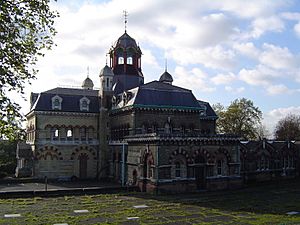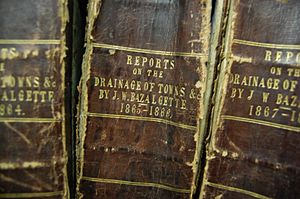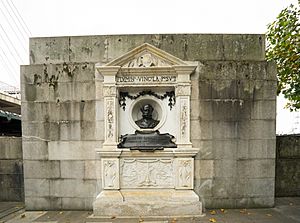Joseph Bazalgette facts for kids
Sir Joseph William Bazalgette (born March 28, 1819 – died March 15, 1891) was an important English civil engineer in the 1800s. He is best known for designing London's huge sewer system. This system helped stop deadly cholera outbreaks and started to clean up the River Thames. He also designed the Hammersmith Bridge.
Contents
Joseph Bazalgette's Early Life
Joseph Bazalgette was born in Clay Hill, Enfield, London. His father was a retired captain from the Royal Navy. Joseph's grandfather was a French Protestant immigrant who became very wealthy.
When Joseph was eight, his family moved to St. John's Wood, London. He started his career working for a famous engineer, Sir John Macneill. Joseph gained a lot of experience in draining land and making new land from water. In 1842, he started his own engineering business in London.
In 1845, Joseph married Maria Kough from Ireland. He worked very hard on expanding the railway network. This intense work made him very ill in 1847.
London's Cholera Problem
While Joseph was recovering, London faced a big problem. In 1847, a group called the Metropolitan Commission of Sewers ordered that all cesspits (holes for collecting waste) be closed. They wanted house drains to connect to sewers that emptied into the River Thames. This made the river very dirty.
Because of this, a terrible cholera disease spread in 1849. It killed 14,137 people in London.
Joseph Bazalgette became an assistant surveyor for the Commission in 1849. He became the chief engineer in 1852. Soon after, another cholera outbreak happened in 1853, killing 10,738 people.
At that time, many doctors thought cholera was caused by bad air, a theory called miasma. But a doctor named Dr John Snow believed cholera spread through dirty water. His idea was correct, but most people didn't believe him then.
The Great Stink and a Big Plan
In 1856, Joseph Bazalgette became the chief engineer of the Metropolitan Board of Works. This group took over from the earlier Commission. In 1858, London experienced the "Great Stink". The River Thames smelled so bad that people in Parliament couldn't work.
This terrible smell made Parliament finally agree to a huge and expensive project. Bazalgette's plan to completely change London's sewer system was approved. People hoped that new, enclosed sewers would get rid of the bad smell and, in turn, stop cholera.
Building London's Sewer System
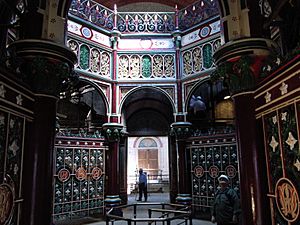
Before Bazalgette's work, the River Thames was like an open sewer. It had no fish or other wildlife and was a huge danger to people's health.
Bazalgette's solution was to build a network of 82 miles (132 km) of large, underground brick sewers. These main sewers would collect all the sewage. He also planned for 1,100 miles (1,770 km) of smaller street sewers. These would stop raw sewage from flowing freely through London's streets into the river.
His plan included major pumping stations. These were built at Deptford (1864), Crossness (1865), Abbey Mills (1868), and on the Chelsea Embankment (1875). The sewage was then sent far downstream. It was collected in two large systems called the Northern and Southern Outfall Sewers. At first, the sewage was stored in tanks and then dumped into the Thames when the tide was high.
The new sewer system was officially opened in 1865 by Edward, Prince of Wales. However, the entire project took another 10 years to finish.
Later, around 1900, better sewage treatment facilities were built. These facilities cleaned the sewage before it went into the river.
How the Sewers Saved Lives
Even though people thought cholera was caused by bad air, Bazalgette's sewers worked. By removing the dirty water from the city, the sewers also removed the bacteria that caused cholera. This almost completely stopped cholera in areas with the new sewers. The system also helped reduce other diseases like typhus and typhoid.
Bazalgette worked incredibly hard. He personally checked every connection to the sewer system. Records show thousands of plans with his handwritten notes, like "Approved JWB" or "I do not like 6 used here and 9 should be used. JWB". It's not surprising that his health suffered from all this work.
Joseph Bazalgette's Private Life
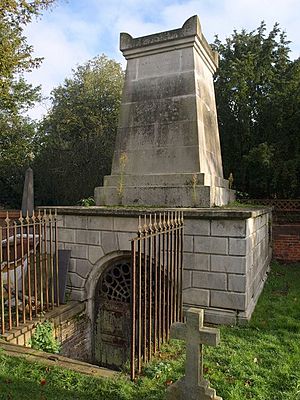
Joseph Bazalgette lived in St John's Wood, north London, for some years. Later, he moved to Morden and then to Wimbledon in 1873. He died in Wimbledon in 1891 and was buried in the churchyard of St Mary's Church nearby.
He married Maria Kough in 1845. They had eleven children:
- Joseph William (born 1846)
- Charles Norman (born 1847)
- Edward (born 1848)
- Theresa Philo (born 1850)
- Caroline (born 1852)
- Maria (born 1854)
- Henry (born 1855)
- Willoughby (born 1857)
- Maria Louise (born 1859)
- Anna Constance (born 1859)
- Evelyn (born 1861)
Awards and Memorials
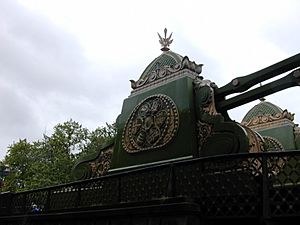
Joseph Bazalgette was made a knight in 1875, so he became "Sir Joseph". In 1883, he was chosen to be the President of the Institution of Civil Engineers.
A Greater London Council blue plaque honors Bazalgette at his old home in St John's Wood. There is also a special monument to him on the Victoria Embankment by the River Thames in central London. In 2020, a new public space near Blackfriars Bridge was named the Bazalgette Embankment in his honor.
Dulwich College offers a scholarship in his name for students interested in design and technology or mathematics and science.
Other Important Works
Joseph Bazalgette also worked on many other important projects, including:
- Albert Embankment (1869)
- Victoria Embankment (1870)
- Chelsea Embankment (1874)
- Maidstone Bridge (1879)
- Modifications to Albert Bridge (1884)
- Putney Bridge (1886)
- Hammersmith Bridge (1887)
- The Woolwich Free Ferry (1889)
- Battersea Bridge (1890)
- Designing major London roads like Charing Cross Road, Garrick Street, Northumberland Avenue, and Shaftesbury Avenue.
- Early plans for the Blackwall Tunnel (1897)
- A proposal for what later became Tower Bridge
Notable Descendants
Some of Joseph Bazalgette's famous descendants include:
- Ian Bazalgette (his great-grandson), an RAF pilot who received the Victoria Cross for bravery.
- Peter Bazalgette (his great-great-grandson), a well-known television producer.
- Edward Bazalgette (his great-great-grandson), a musician and television director.
See also
 In Spanish: Joseph Bazalgette para niños
In Spanish: Joseph Bazalgette para niños



